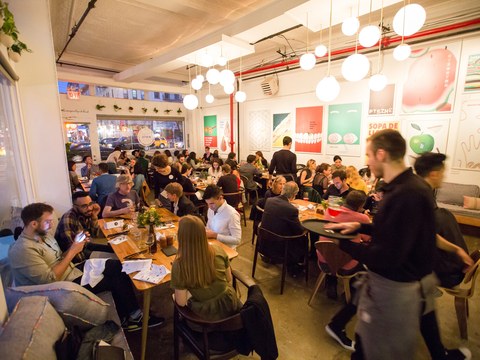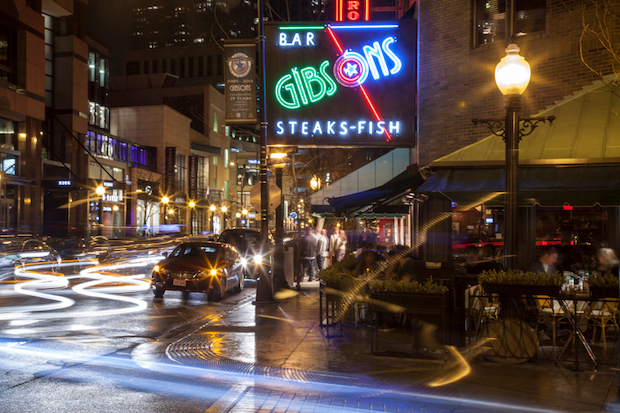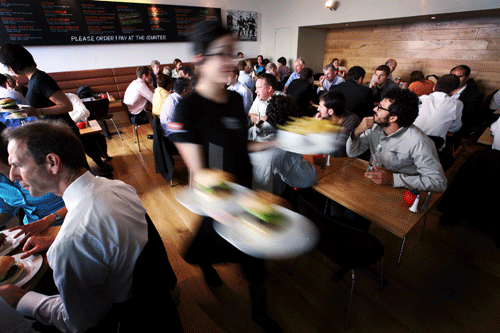
Dec 7, 2018
Ravi Baichwal | ABC 7 Chicago | December 3, 2018
Watch for more pop-up restaurants, stores and services across Chicago.
The city unveiled a new licensing system Monday to make it easier for micro-businesses to open. It’s a way to cultivate entrepreneurship in the city’s diverse neighborhoods.
At the corner of 79th and Woodlawn sits a community hub bursting with economic activity. The brainchild of Donnell Digby, The Woodlawn hosts small businesses looking to get traction for their wares — in this case, comfort food from Doughboy’s Chicago. The Woodlawn is the recipient of Chicago’s first license as a pop-up host.
“We are here to bring opportunity to fellow entrepreneurs, chefs, caterers to come into our space and bring their menus and their experience here and try and give it to the community,” Digby said.
A rotating cast of pop-up chefs will now be able to obtain licenses for 30 to 90 days costing no more than $100 to establish a retail track record. Non-food businesses are expected to join in as well.
“A lot of individuals who maybe didn’t know how to do it, the guidance, the format, the structure now is there to grow their dreams,” said Chris Dofriesen, Doughboy Chicago.
The city shadowed these and other entrepreneurs in the food, fashion and media worlds, among others, and saw they were creating economic activity. But there needed to be a regulatory framework to allow them to formalize their businesses.
“To not only support him, but all the entrepreneurs, through his kitchen and through being a pop-up host to allow the pop-up users to come in, those users can then go and pop in and out of other locations throughout the city,” Chicago Department of Business Affairs Commissioner Rosa Escareno said.
CONTINUE READING

Nov 30, 2018
John Pletz | Crain’s Chicago Business | November 28, 2018
Tock, a Chicago maker of restaurant-reservation software, is sticking around for a third course.
Even as consolidation has claimed other rivals to OpenTable—such as Reserve, which recently was acquired by Resy—Tock marches on. The four-year-old company raised $9.5 million in its third round of funding.
The deal was led by local investors Valor Equity Partners, a venture fund run by Antonio Gracias, and Origin Ventures, the fund that backed Grubhub and led Tock’s $7.5 million round two years ago.
Other local investors include Matt Maloney, co-founder and CEO of Grubhub, who also is a Tock board member; Lettuce Entertainment Enterprises; Hyde Park Venture Partners; Chicago Ventures; Pritzker Group Venture Capital; Howard Tullman’s G2T3V fund; and star chefs Thomas Keller and Andrew Zimmern.
Tock has never lacked for star power. It was co-founded by Nick Kokonas, a business partner with chef Grant Achatz in Alinea and several other top Chicago restaurants, and former Google engineer Brian Fitzpatrick.
They built Tock to handle prepaid bookings that are favored by Alinea and other high-end restaurants, as well as manage reservations and relationships with customers. The question has always been whether Tock could also serve chains and other less-exclusive restaurants.
“We’re starting to get large restaurant groups,” Kokonas said. He points to Burger & Lobster, an 18-restaurant chain in the U.K., and a larger deal that he expects to announce in January.
CONTINUE READING

Nov 16, 2018
Phil Vettel | Chicago Tribune | November 12, 2018
Le Sud is only 7 weeks old, but already looks like a hit. It has a veteran management team, a chef who cooks with intelligence and purpose, an interesting and highly affordable wine list, and bright, attentive service.
Good night, everybody!
OK, details. Le Sud (“the south”) sits on the western fringe of Roscoe Village, a cute-as-a-button corner space with 120 seats, divided equally between main-level and second-floor dining rooms. (The latter, with its own bar, is suitable for private events.) The decor is a Chicago-meets-Provence look that includes stamped-pattern silver ceiling tiles, exposed brick walls, ornate-framed mirrors, wall-mounted dinner plates and cute chandeliers that resemble uplit milk bottles.
Above the pass (the space between kitchen and dining room) is a shelf with cookbooks and knickknacks, against a slab of black slate painted with food and wine images and the phrases a votre sante (“to your health”) and nourriture de comfort (“comfort food,” though it really ought to be confort). The menu adopts the old-school approach of labeling appetizers “les entrees” and main courses “les plats.”
Given the general decline in the number of French restaurants in Chicago — particularly the dearth of new openings — these unapologetic accents carry a certain “come at me bro” bravado.
Which apparently resonates among the locals: The downstairs dining room has been filled, or nearly so, on all of my visits (none of them on the weekend). In a smart move, Le Sud takes reservations only for half its capacity, encouraging walk-in guests.
Owner Sandy Chen, who also owns Koi Fine Asian Cuisine in Evanston, took her inspiration from her travels in Southern France. But the menu, by executive chef Ryan Brosseau (Perennial Virant, Table, Donkey & Stick), also dips its toes into the Mediterranean from time to time.
CONTINUE READING

Nov 9, 2018
Pedanco | November 2018
Think about how much it costs to acquire a new customer.
You put up expensive signage inside and outside the restaurant. Your website itself (not to mention the management of it) comes with a monthly cost. You run promotions in-house and offer discounts online to lure customers in. You try to maintain a regular presence on social media. Not to mention the costs of pay-per-click advertising on Google and Facebook.
Oh! And don’t forget about the cost of your marketing team.
Then, of course, there’s the cost to keep your restaurant fully operational in order to make a good impression and provide a great guest experience.
You spend a lot of money in order to attract new clientele. But is it working?
While you may see an increase in foot traffic and online orders from your efforts, have you given any thought to the quality of customers you’ve attracted?
If you’re struggling with low profit margins and high turnover rates, it’s time to do some simple calculations to figure out what has gone wrong.
Calculating the Customer Lifetime Value of Your Restaurant Guests
The customer lifetime value (CLV or, sometimes, just LTV) is a calculation every business must do. And it’s a simple one at that. Basically, it tells you what the monetary return will be on the average guest in your restaurant. If you’re investing all this money in marketing to and bringing in new business, you should know what exactly you’re getting in exchange for your efforts.
Before you do the calculation, you will need to gather some data from the previous year’s sales. Make sure it’s a full year’s worth of data you’re working with.
CONTINUE READING

Nov 2, 2018
Ashok Selvam | Eater | October 25, 2018
Yes, for yet another year Gibsons Bar & Steakhouse in the Gold Coast is the top-grossing independent restaurant in Chicago, according to the latest Restaurant Business Online top 100 list. This year, Gibsons made $25.5 million in sales, a 2.9 percent increase from 2017’s numbers. Gibsons also moved up one spot nationally, from No. 10 to No. 9 this year.
Twelve Chicago restaurants and three suburban locations made the list, giving Illinois 15 restaurants overall. That’s more than double from last year when seven restaurants were mentioned. Primehouse, which closed, is the only local restaurant that dropped.
There’s an obvious skew toward pricey steakhouses as 31 steakhouses made the list nationally. Eleven of those are from the Chicago area. Restaurant Business picked up on that and featured Swift & Sons — Boka Restaurant Group’s Fulton Market steakhouse — in a story about emerging brands. Swift & Sons made the list for the first time and Maple & Ash in Gold Coast was another first-timer. While five Gibsons restaurants made the list, its new riverfront restaurant that opened in October 2017, Gibsons Italia, failed to scratch the rankings. It’s unclear if that’s because the restaurant was still too new for consideration.
The question for many is what will the list look like in 2019 for Chicago? That’s when the list will take into account TAO’s arrival to River North. The clubstaurant chain once again is the top-grossing restaurant in the country, as the Las Vegas location brought in $43.4 million in sales. Two TAO locations in New York also appear on the list at No. 4 and No. 12. Will TAO, which imported Kardashians to the River North opening in September, make an impact on Chicago’s dining scene? Next year, the Smith, a New York restaurant with three locations in the top 100, is also heading to Chicago.
The Chicago-area restaurants that made the list, along with the national rankings and sales numbers, are listed below.
- Gibsons Gold Coast (No. 9, $25.5 million)
- Joe’s Seafood, Prime Steak & Stone Crab (No. 20, $21.3 million)
- Maple & Ash (No. 24, $20.3 million)
- RPM Steak (No. 26, $20.25 million)
- Gibsons Oak Brook (No. 37, $18.3 million)
Full List

Oct 26, 2018
Carla Vianna | Eater New York | October 23, 2018
Restaurants struggling to cope with pricey rent hikes may benefit from a proposed bill — discussed Monday in City Council — that seeks to level the playing field between landlords and commercial tenants in NYC.
The bill, dubbed the Small Business Jobs Survival Act, gives tenants a right to a lease renewal, including a 10-year term for those in good standing. It also lets tenants demand arbitration if a rent hike is too high and extends to all commercial businesses, including restaurants. NYC currently has no restrictions on commercial rent increases.
It’s heavily supported by groups like the Friends of SBJSA, founded by historian and Columbia University professor David Eisenbach, and the Greenwich Village Society for Historic Preservation, who say the city is losing the bulk of its small businesses to hefty rent hikes they can’t afford.
But the bill faces stiff opposition from real estate powerhouses, as well as other organizations like the Manhattan Chamber of Commerce. Real Estate Board of New York, a big opposer of the bill, argues that it fails to tackle the real issues that mom-and-pop shops are facing — like changes to minimum wages. Others say the bill would unleash a series of unintended consequences, such as discouraging landlords from renting their spaces to small operators.
The City Council’s Committee on Small Business discussed the bill Monday, October 22, and moving forward, changes are expected with both sides airing their concerns. It’s been three decades since a similar bill was first proposed, but nothing has ever solidified.
CONTINUE READING






